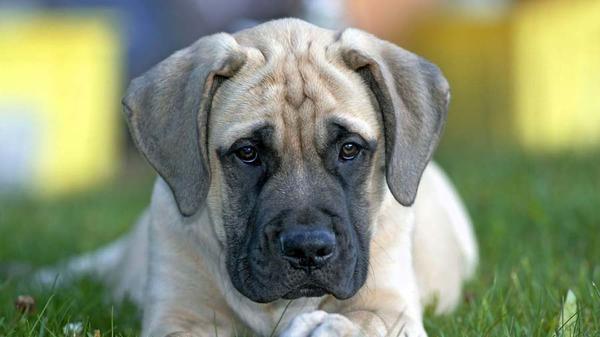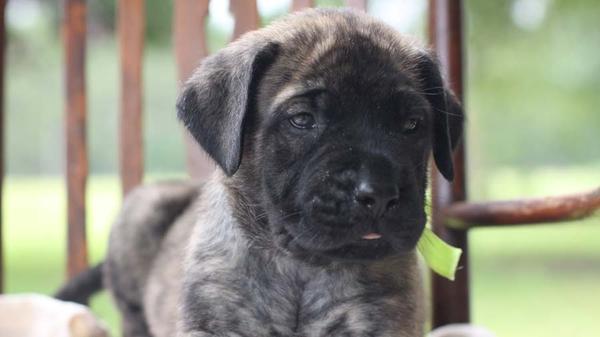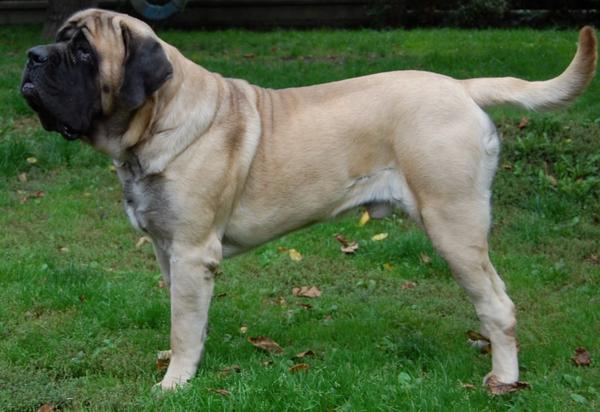Mastiff
also known as Old English Mastiff, English Mastiff

 History
History
The Mastiff is a large, powerful breed with a rich history dating back to ancient times. This majestic breed, also known as the English Mastiff, has been used for a variety of purposes throughout its long history, including as a war dog, a hunting companion, and a protector of families and property.
The breed's name, Mastiff, is derived from the Old English word "masty," which means "powerful." The Mastiff is one of the oldest breeds of dogs, with evidence of its existence dating back to at least 2500 B.C. in ancient Egypt. The breed was also known in ancient Rome and was used by the Roman army in battles.
The Mastiff was officially recognized by the American Kennel Club (AKC) in 1885 and by the United Kingdom's Kennel Club in 1891.
The Mastiff has undergone several changes throughout its history. In the 19th century, the breed was crossed with the Bulldog to create the "Bullmastiff," a breed that was used for hunting and as a gamekeeper's companion. However, this had a negative impact on the breed's health and temperament.
In the late 19th and early 20th century, a group of English breeders, led by Mr. James Watson, made a concerted effort to restore the Mastiff to its original form. They selected the most massive and powerful specimens to breed and their efforts paid off, resulting in the Mastiff we know today
Breed Information
Is Mastiff a purebred?
Purebred
What were Mastiffs originally used for?
Guardian
How Long Do Mastiffs Live? What is average life expectancy for a Mastiff? How long can Mastiffs live?
10-12 years
The average Mastiff lifespan is somewhere between 10-12 years, provided they aren't beset by any exceptional health issues or injuries.
Mastiff Height & Weight
How big is a full grown Mastiff?

| Height | ||||
|---|---|---|---|---|
| Average | 6 months | 12 months | 18 months | |
| Male | 30-36 inches (76.2 - 91.4 cm) | 27.5 inches (69.9 cm) | 30.0 inches (76.2 cm) | 33.0 inches (83.8 cm) |
| Female | 28-36 inches (71.1 - 91.4 cm) | 27.0 inches (68.6 cm) | 29.0 inches (73.7 cm) | 32.0 inches (81.3 cm) |
| Weight | ||||
|---|---|---|---|---|
| Average | 6 months | 12 months | 18 months | |
| Male | 170-230 pounds (77 - 104 kg) | 120.0 pounds (54 kg) | 160.0 pounds (73 kg) | 200.0 pounds (91 kg) |
| Female | 120-170 pounds (54 - 77 kg) | 90.0 pounds (41 kg) | 110.0 pounds (50 kg) | 145.0 pounds (66 kg) |
Do Mastiffs get fat easily?
![]()
![]()
![]()
![]()
![]()
The Mastiff is a breed that has an average to high tendency to gain weight if their weight is not closely monitored. It is important to maintain a balance between exercise and food intake to keep them at a healthy weight. This can be achieved by scheduling at least one daily walk and engaging in regular playtime with them.
Are Mastiffs Hypoallergenic?
No
Unfortunately, the Mastiff is not hypoallergenic, making it not a good choice for a dog lover who suffers from pet allergies.
What is a Mastiff personality? What are Mastiff dogs best known for?
Affectionate
Cheerful
Intelligent
Protective
Alert
Courageous
Loyal
Are Mastiffs heavy shedders? How Much Does a Mastiff Shed?
![]()
![]()
![]()
![]()
![]()
Mastiff dogs are not heavy shedders, but they will lose a significant amount of hair each year. To decrease the amount of shedding, you can regularly brush your Mastiff. This will remove loose hair and keep his coat growing in the same direction.
What is the watchdog ability of a Mastiff dog?
![]()
![]()
![]()
![]()
![]()
The Mastiff dog is one of the best choice if you want a good watchdog. This breed will keep watch over you and your family at all times. This breed takes this task seriously and will typically perform its guarding duty with little to no training. This dog will require obedience training, or you can consider guard dog training to sharpen its skills.
Breed History
Where do Mastiffs come from?
England
What are Mastiffs descended from?
Molosser-type Dogs
What organizations or kennel clubs recognize/register the Mastiff breed?
American Canine Registry
American Kennel Club
America's Pet Registry
Canadian Kennel Club
Dog Registry of America Inc.
Federation Cynologique Internationale
Kennel Club of Great Britain
North American Purebred Registry, Inc.
American Canine Association, Inc.
Australian National Kennel Council
Continental Kennel Club
National Kennel Club
New Zealand Kennel Club
United Kennel Club
When were Mastiffs first bred? How old is the Mastiff breed?
1800s
What Breed Group is a Mastiff?
Working (AKC:1885)
Guardian Dog (UKC)

Mastiff Appearance
What color are Mastiff eyes?
Brown
What color can Mastiff nose be naturally?
Black
What color can Mastiff coat be naturally?
Cream
Fawn
Brindle
How long is a Mastiffs coat?
![]()
![]()
![]()
![]()
![]()
Mastiffs are known for their short coat.
How Dense Is The Mastiff Coat?
![]()
![]()
![]()
![]()
![]()
What is the texture of the hair of a Mastiff?
Straight
How many puppies can a Mastiff have in a litter? How many puppies can a Mastiff have in her first litter?
10-12 puppies per pregnancy
A Mastiff can have a litter of 10-12 puppies on average. However, it's worth noting that the size of the litters can vary greatly. Factors that can influence litter size include the health of the mother, breeding history, and genetics.
![]()
![]()
![]()
![]()
![]()
Mastiffs are known for their adaptability and versatility, they are capable of adapting well to a wide range of lifestyle changes and living environments. They are a highly adaptable breed, and make great companions for families and individuals of all lifestyles.

Mastiff Health Issues
Do Mastiffs have a lot of health problems?
![]()
![]()
![]()
![]()
![]()
The Mastiff breed is commonly healthy with low vet costs, regular check-ups may not be as necessary but it's important to keep an eye on their health and have them checked by a veterinarian when needed.
What are the major health concerns to be aware of when owning a Mastiff?
Gastric Torsion
Hip Dysplasia
What are the less significant issues to keep in mind when it comes to Mastiffs?
Entropion
Ectropion
Elbow Dysplasia
Progressive Retinal Atrophy
Retinal Dysplasia
Hypothyroidism
What are the occasional tests recommended for Mastiff breed?
Eye
Hip
Elbow
Thyroid Tests
X-Rays
Eye Examination

Mastiff Needs and Activities
Do Mastiffs have a lot of energy?
![]()
![]()
![]()
![]()
![]()
Mastiffs may be a good breed for those who prefer a more relaxed lifestyle. They tend to have a lower energy level than other breeds of dogs.
Do Mastiffs need socialization? How social are Mastiffs?
![]()
![]()
![]()
![]()
![]()
Mastiffs have average social needs compared to other breeds. They are known to be less active and independent than other breeds, and they are content with spending time alone and with their human family.
How much exercise should Mastiffs get?
![]()
![]()
![]()
![]()
![]()
The Mastiffs a breed that requires only a small amount of physical activity to maintain a healthy lifestyle. These breeds are ideal for people with busy lifestyles, elderly people or those who have limited mobility. They also make great pets for those who live in small apartments or have limited outdoor space.
How much sleep should a Mastiff have? Do Mastiffs sleep a lot?
![]()
![]()
![]()
![]()
![]()
The Mastiff breed is known for their relaxed and calm nature and tendency to sleep for long periods of time.
Does a Mastiff drool a lot?
![]()
![]()
![]()
![]()
![]()
The Mastiff is a breed known for excessive drooling which can cause a lot of drool to be left on clothes. If this is unappealing to you, it may be best to consider a different breed of dog.
How much does it bark?
![]()
![]()
![]()
![]()
![]()
Mastiffs are known to bark very little or not at all. They tend to be very quiet and do not bark excessively. They may only bark in specific situations, such as when they need to alert their owner to something important or when they are in distress.
Do Mastiffs exhibit aggressive behavior to safeguard their home and territory? Do they possess a natural tendency to guard?
![]()
![]()
![]()
![]()
![]()
These dogs are known for being extremely protective and make excellent guard dogs. They possess a strong instinct to defend their territory and owners and have a high level of vigilance and alertness.
Are Mastiffs mouthy?
![]()
![]()
![]()
![]()
![]()
What is the likelihood of a Mastiff running away? Do they have a tendency to explore or wander frequently?
![]()
![]()
![]()
![]()
![]()
Do Mastiff dogs have a high prey drive?
![]()
![]()
![]()
![]()
![]()
What do Mastiffs enjoy doing? How do I keep my Mastiff busy?
Snuggling, Sleeping, Eating, Eating Snacks, Walk, Catch treats, Nap, Walking, Tug-of-war, People petts, Chase, Fetch, Running
What is the energy level of a Mastiff? How much energy does a Mastiff have?
Medium
Mastiffs are medium-energy dogs and typically enjoy socializing and playing casual or even sustained games of chase with other dogs. They may also have occasional periods of barking or racing around the house.
![]()
![]()
![]()
![]()
![]()
How far should a Mastiff walk each week? How many miles should a Mastiff walk every week?
15 miles / week
There's really no limit to how far you walk your dog as long as they're comfortable. For Mastiff, it's at least 15 miles / week. Just remember to build distance and stamina gradually over time.
How much a Mastiff should exercise a day? How much activity does a Mastiff need?
60 minutes
In general most Mastiffs usually need at least 60 minutes of exercise daily. This can be spread across the day and include all sorts of high-energy activities, like walking, running and playing.
What level of grooming should be provided for a Mastiff?
![]()
![]()
![]()
![]()
![]()
The Mastiff is a breed of dog that is known for its low grooming needs.
How often should you brush a Mastiff?
Weekly
Mastiff should be brushed at least once a week. Of course you can give them more frequent brushes if you find that they are still shedding a lot
What are the most commonly used brushing tools for Mastiffs?
Pin Brush
Nail Clipper
Costs
How many cups of food does a Mastiff eat?
8.5 cups
For an average 170-230 pound (77 - 104 kg) Mastiff feed 8.5 cups daily. But, keep in mind, the amount you feed is going to be dependent on the quality of the food you are feeding.
How Much Does a Mastiff Cost Daily?
$8.40 - $9.10 / day
The average cost of a Mastiff is somewhere $8.40 - $9.10 per day.
How Much Does a Mastiff Cost Per Month?
$252 - $273 / month
The average per month expenses of a Mastiff is between $252 - $273. This makes an average of $3024 - $3276 per year. It will be on the higher side when the dog is still small because it will need more frequent visits to the vet, shots.
Mastiff Characteristic
How intelligent is a Mastiff?
![]()
![]()
![]()
![]()
![]()
Mastiffs has average obedience intelligence. But, they're also independent thinkers. The Mastiff is a breed with an exceptionally high IQ and may get into mischief if left to their own devices.
How sensitive is a Mastiff dog?
![]()
![]()
![]()
![]()
![]()
Mastiff dogs have average emotions and are adaptable to different situations, not requiring extra care like sensitive breeds do.
Are Mastiff dogs affectionate?
![]()
![]()
![]()
![]()
![]()
Do Mastiff do well in apartments? Are Mastiffs good indoor dogs?
![]()
![]()
![]()
![]()
![]()
Mastiffs are dogs that do well in apartments with sufficient exercise, but they would really appreciate a small yard.
Are Mastiffs good with kids? Are Mastiffs good around children?
![]()
![]()
![]()
![]()
![]()
A Mastiffs typical characteristics indicate that this breed of dog is an ideal companion for kids and makes them family pets. Their gentle and protective nature and calm mentality make them gel along quickly with the younger humans
Are Mastiffs good for elderly?
![]()
![]()
![]()
![]()
![]()
Are Mastiffs good with cats? How friendly Mastiffs are toward cats?
![]()
![]()
![]()
![]()
![]()
Mastiffs are very cat friendly dogs. They generally make good companions for cats.
Do Mastiff dogs get along with other dogs? Are Mastiffs OK with other dogs?
![]()
![]()
![]()
![]()
![]()
Mastiffs are average friendly towards other dogs. If they are raised with other dogs, they are likely to get along with them. And, if they are socialized properly from a young age, they will usually be great with other dogs.
How do Mastiff dogs interact with other pets? Are they considered pet-friendly?
![]()
![]()
![]()
![]()
![]()
Are Mastiffs friendly with strangers?
![]()
![]()
![]()
![]()
![]()
Mastiffs are average friendly around strangers. They can be wary around strangers and a little standoffish. Early socialisation is key.
Do Mastiffs like to play? Are Mastiffs playful?
![]()
![]()
![]()
![]()
![]()
Mastiffs are not the most playful dog breed.
Are Mastiff easily trained?
![]()
![]()
![]()
![]()
![]()
Mastiff dogs are usually easy to train, but may require consistency to fully obey commands.
 Pros & Cons
Pros & Cons
Pros
- Cat Friendly
Mastiff dogs get along well with cats. - Quiet
If you're looking for a quieter breed, the Mastiff dog could be a good option as they are known for being relatively silent. - Affectionate and loyal to their family
Mastiff are known for being affectionate and loyal to their family. - Rarely barks
The Mastiff dog may be a good choice for those looking for a peaceful pet as they are known for being relatively silent. - Good with children
They are good with children and make great playmates. - Low energy levels
They have low energy levels and are relatively calm and relaxed.
Cons
- Large size
Mastiff is a large breed which requires a lot of space. - Not Hypoallergenic
If you have allergies, you may want to avoid Mastiffs, as they have been known to cause allergic reactions. - Tendency to gain weight
The Mastiff's weight can become problematic if not monitored closely. - Odor
The Mastiff has a substantial risk of having bad smell. - Not suitable for office environment
Mastiffs are not generally considered to be office-friendly dogs. - Drooling
They are known to drool and slobber a lot.